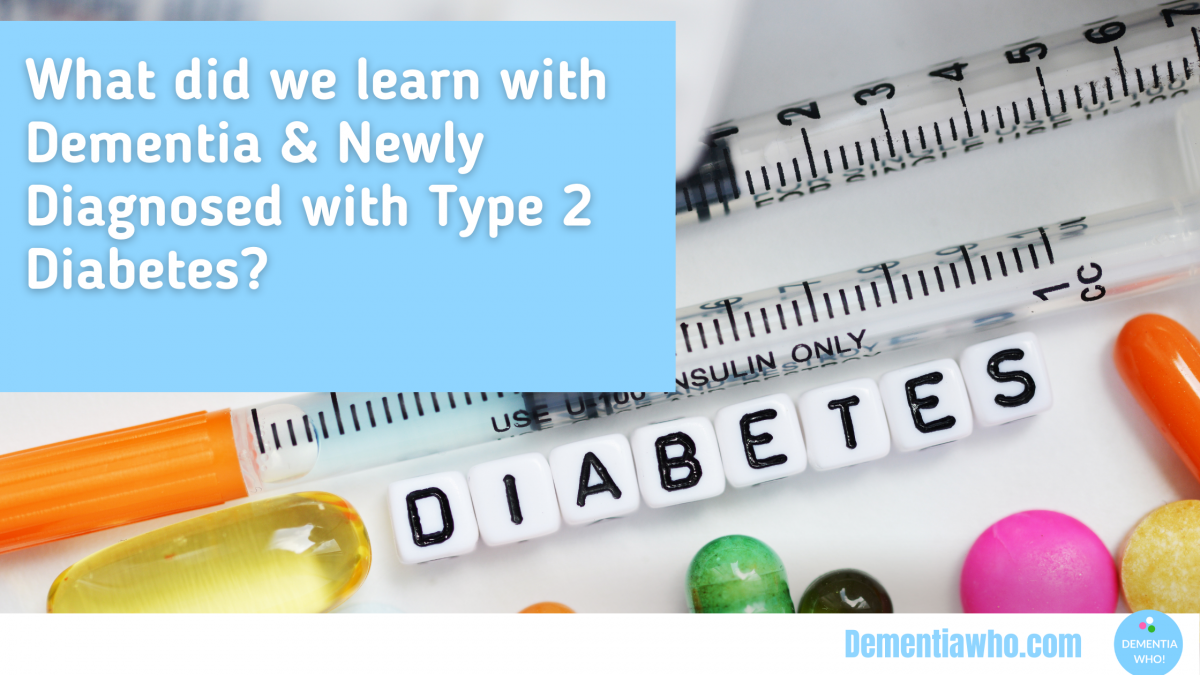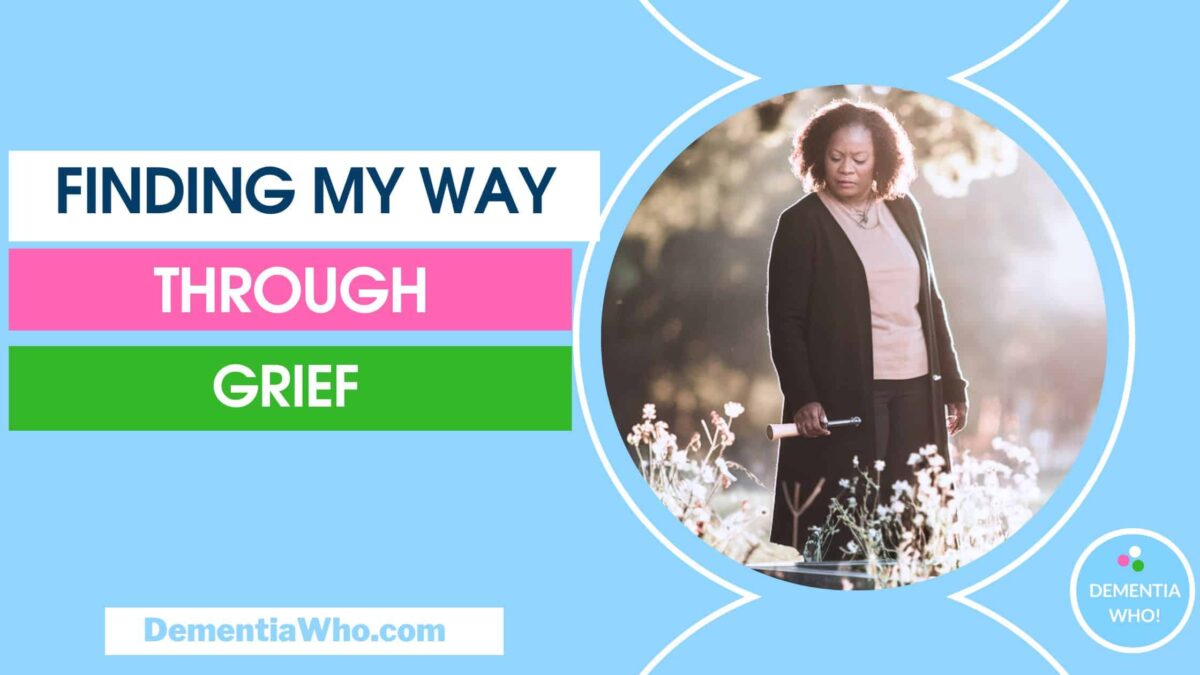Mum was one of 850,000 people estimated walking around undiagnosed with diabetes. It’s been over 6 months since mum was in the hospital with dementia & newly diagnosed with Type 2 diabetes. Looking back, what have we learned?

What is type 2 Diabetes?
Type 2 Diabetes is where the glucose level in the blood is too high because it can’t be converted into energy.
The insulin produced in your body is either too little or is resistant and can’t unlock the blood cells used to convert glucose into energy.
Trying to explain that to someone with dementia is challenging. So we’ve learnt to simplify it – ‘to you have too much sugar in your blood, and that’s how mum understands’.
Whilst you’re here, why not sign up to get my latest posts by email
What happens after being diagnosed with diabetes?
We were discharged from the hospital with a leaflet, signposted back to our doctors and a box of medication. We were left floundering on what we should be doing and how we should be managing her diabetes.
I had a feeling of deja vu, left to our own devices again to learn all about another disease. At least we should be grateful there are only two types of diabetes vs the 100’s types of dementia.
We were anxious, worried about what we could eat, and concerned about medication side effects and how this would impact mum’s dementia.
As a caregiver, I always wanted to make the situation as easy as possible, but it was tough to help her understand with her Alzheimer’s what had happened or that she now had diabetes.
Looking back on it now, it’s not so bad, but at the time, my stress level was astronomical because we had to wait for the referrals for help. All we had was the internet, and that’s a scary place to look for information when you’re already in a stressed state!
So be prepared to wait a while before you can get in-person expert help.
Be prepared to wait for expert advice
What happened at the initial referral to GP Surgery?
A nurse at the GP surgery explained that we’d remain on the medication for the time being and made a referral to a specialist diabetes nurse. I was initially denied the request for a glucose meter to test mum’s sugar levels. The narrative was that the medication would reduce mum’s blood sugars over the coming days, so mum didn’t need a meter.
I didn’t understand the logic to this, everything I’d read, referred to learning how carbs impact your glucose levels. They advise you to check your glucose before eating and, on average, 2 hours after every meal to see how it affects you. Every person is affected differently when eating carbs, so it didn’t make sense.
In the beginning, you need to know what foods impact your blood sugar levels the most!
I’m glad I spent that time researching as I was able to argue my case with the nurse until she relented and provided a meter.
Research and learn what you can & be prepared to fight for what you need!
Getting the support you need
Being referred to a Specialist Diabetic Nurse is where we were finally heard, and she became our diabetes expert support system. She was in regular contact and helped get mum into a better position health-wise for her surgery (more on that later). She was always a phone call away and often visited. She helped us by:-
- answering all our questions
- allying all our fears
- described the treatment options for diabetes
- Diet
- Medication
- Exercise
- Explaining that it’s a lifelong condition that can be managed
- Side effects about the medication and when/why doses would be changed
- risks associated with diabetes – increased risk of heart disease, stroke, feet and kidneys issues
- set up a referral to specialist eye clinic
- Advised where to get further help and reliable information
We discussed mum’s HBA1C blood test, which looks at the average blood glucose level in your blood over the last 3 months and what we need to do to bring levels down. We rejected the insulin option for various reasons, primarily because she wouldn’t tolerate injections every day.
We agreed to manage the condition with the medication and diet alone.
Managing diabetes with a diet can be tricky if you’re used to eating carbs as part of your daily diet. Everything I’d read on the web suggested a Keto style diet that is extremely low carb and not suitable for mum.
The diabetic nurse agreed – there is no point completely changing her diet to such a strict regime that you’re unlikely to stick to it.
Given mum’s age and weight, the nurse explained how many carbs per meal and over a day she needed to help bring down her glucose levels.
She was a fantastic nurse who always made an effort to help.
Get a good support systen in place
How to check your blood glucose level?
There are various ways to monitor blood glucose. The main options are a glucose meter or wearable sensor device known as Flash Glucose monitoring.
Glucose Meter
This type of meter uses a fingerprick sample of blood. So you need to use a lancet to prick the finger, and a test strip inserted into the meter, and you put a drop of blood on the strip. The meter then displays what your glucose level is at the time.
The advantages are it’s more affordable, doesn’t involve a full blood draw, and for someone with early dementia, they could do this themselves.
The disadvantage is repeated testing is painful, your fingers can become numb, and it can discourage testing.
With someone with Alzheimer’s, it gets harder and harder to do. In my case, when mum saw the meter, she’d retained the feeling that this wasn’t something good and started to pull away when we tried to test.
Flash glucose monitors
This type is a sensor worn for a specified time on the body.
We tried the Freestyle Libre 2 sensor. This sensor is inserted into the back of the arm for 14 days. It then takes glucose readings from the interstitial fluid below your skin. So the only painful moment is when it’s first inserted.
Sensor readings are taken via your smartphone, or a reader device swiped near the sensor. The sensor won’t give you the exact reading as you would get from a direct blood test, but it is incredibly close, and as long as a reading is taken every 8 hours, you get a picture of your glucose levels over that day.
The advantages are it provides a continuous reading as long as it’s swiped every 8 hours. It indicates when your glucose rises or warns with an alarm when getting critically low, even when you’re sleeping. And it’s not painful to use. The data can be downloaded and shared with health professionals.
The disadvantages are that it’s an expensive option and needs replacing every 14 days. Unfortunately, it isn’t as accurate, and sometimes you can knock the sensor out of your arm if not careful.
I would advise anyone newly diagnosed to try them for 14 days (free trial) and monitor your food during that time to get an idea of carbohydrate impact.
After that time, for type 2 diabetes, it is used for reassurance, as once you have a stable diet, your glucose levels won’t spike most of the time.
We chose to use the sensor simply for peace of mind, given mum’s other health conditions.
Choose the glucose monitoring system that works best for your situation
What should newly diagnosed diabetic eat?
Eat carbs or not – it gets confusing as it depends on what type of medication you are on and whether you’re on insulin. You can cut out all unnecessary sugars, reduce carbohydrate intake, use dietary swaps and reduce your portion. Just remember to test your glucose levels. Examples like:-
- Alternatives to main staples – cauliflower rice, courgetti, spaghetti squash, vegetable chips, celeriac mash
- Swapping to wholegrain products – wholemeal bread, pasta, rice
- Swapping milk to unsweetened plant based milk
- Sweetners vs sugar like stevia
- Swap from high sugar fruit to berries etc
- Increased protein, vegetable and fat intake – eating more nuts, varying protein and vegetable options, eating the rainbow
What’s the right portion size for a diabetic?
The easiest way to work out the right portion size for a person with diabetes is to measure with your hands. Portion size is based on individual dietary needs, so a more straightforward measure is to use your hand to estimate your protein, carbohydrates and fat.
Another option is to purchase portion control plates, but you have to be careful to measure your glucose to ensure the plate ratio works for you.
Finally, you can use the guide per 100g on the back of the packet of the product you consume and work out grams per portion.
Our specialist diabetic nurse recommended this book, Carbs & Cals: Carb & Calorie Counter, to help us visualise portion sizes on a plate better for popular food choices. It’s convenient and helpful, especially at the beginning of your diabetes diagnosis.
You can also refer to Diabetes UK who have information on portion control.
Do make diet changes but ensure that they are sustainable
And……What have we learnt as newly diagnosed diabetic?
We’ve learnt to relax our dietary swaps, know what spikes our glucose levels, see the patterns that have emerged, and know what steps we can take to mitigate any issues.
We’re working on the final component exercise – a difficult one with other health conditions, but one I would encourage others to do as it really helps lower your glucose, so go out there and do something that you love.
Following the advice we received, we reduced the HBA1C figure by half—a fantastic result for mum’s age, Alzheimer’s, and her other health conditions. I hope the same for you.







